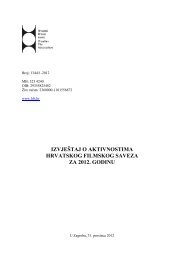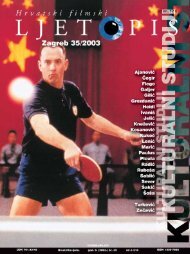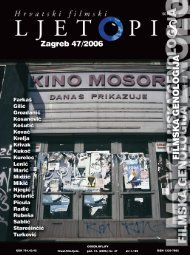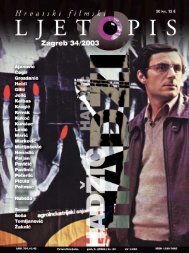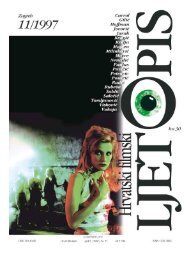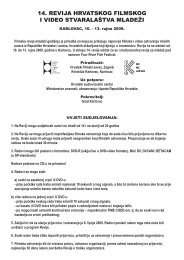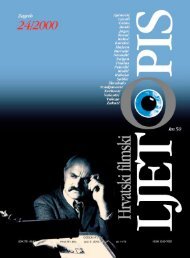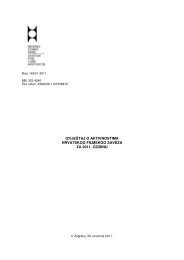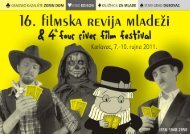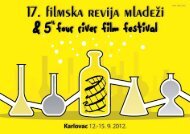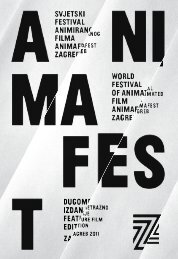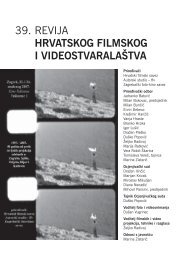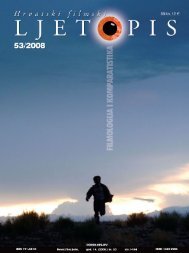Hrvatski filmski ljetopis, broj 56 (2008) - Hrvatski filmski savez
Hrvatski filmski ljetopis, broj 56 (2008) - Hrvatski filmski savez
Hrvatski filmski ljetopis, broj 56 (2008) - Hrvatski filmski savez
You also want an ePaper? Increase the reach of your titles
YUMPU automatically turns print PDFs into web optimized ePapers that Google loves.
hfl_<strong>56</strong>-q6.qxp <strong>2008</strong>-12-18 15:22 Page 173<br />
Hrvat. film. ljeto, Zagreb / god 14 (<strong>2008</strong>), br. <strong>56</strong>, str. 167 do 174 Sa`eci / Summaries<br />
dio europskoga i svjetskoga filmskog i kulturnog naslije|a. Bez takvog polazi{ta<br />
u razmatranju problema vrednovanja filmskoga gradiva nemogu}e je<br />
utvrditi vrijednost pojedinog djela ili ve}ih cjelina i to sa stajali{ta pojedinoga<br />
filmskog roda, vrste, autorskog opusa i sli~no. Takav pristup u vrednovanju<br />
filmskoga gradiva nu`an je posebno u radu filmskog arhiva jer je on<br />
precizan i svrhovit i zbog stalne potrebe prosu|ivanja Nacionalne filmske<br />
zbirke radi provo|enja primjerenih mjera za{tite: restauracije, rekonstrukcije<br />
te izradbe zamjenskog izvornog filmskoga gradiva, {to je temeljna zada-<br />
}a svakog nacionalnog filmskog arhiva.<br />
Tatjana Rezec Stibilj<br />
^etrdeset godina Slovenskoga filmskog<br />
arhiva pri Arhivu Republike Slovenije<br />
UDK: 791.53:930.25(497.4)<br />
Povijesni pregled rada i temeljnih djelatnosti Slovenskoga filmskog arhiva,<br />
koji ove godine obilje`ava 40 godina osnutka. Na prostoru biv{e Jugoslavije<br />
nakon 1945. godine isprva je osnovana Jugoslovenska kinoteka u Beogradu,<br />
koja je od 1957. do 1971. imala status <strong>savez</strong>ne ustanove gdje su filmsku<br />
produkciju ~uvala republi~ka filmska poduze}a, pa tako i slovenski Triglav<br />
film. Godine 1968. pri Arhivu Socijalisti~ke Republike Slovenije osnovan<br />
je odjel Slovenski <strong>filmski</strong> arhiv (u nastavku SFA), specijaliziran za evidentiranje,<br />
skupljanje, odr`avanje i ~uvanje slovenskog filmskog naslije|a.<br />
SNIMATELJSKI PRILOZI<br />
Enes Mid`i}<br />
Mit o prvoj vo`nji kamere i snimci s<br />
mleta~ke gondole<br />
UDK: 778.53(091)<br />
Podatak da je Promio 1896. godine u Veneciji snimio Canal Grande kamerom<br />
iz gondole u vo`nji znat }e spomenuti svaki povjesni~ar filma. No, niti<br />
je prvu filmsku vo`nju izveo Promio, a sasvim je neuvjerljivo da je ta vo`nja<br />
kamere izvedena gondolom. Za prvu je tvrdnju dovoljno prelistati precizne<br />
onodobne ili pak danas a`urirane i sistematizirane kataloge tvrtke Lumière<br />
ili onodobne novinske napise iz Lyona, koji spominju filmske vo`nje datirane<br />
prije Promiove (film koji predstavlja prvu poznatu snimku kamerom u<br />
vo`nji je Panorama pris d'un bateau, kat. br. 130, snimljen 21. rujna 1896.<br />
u Kölnu s parobroda na Rajni). Dokazom druge tvrdnje detaljno se bavi<br />
ovaj tekst, analiziraju}i sa snimateljskog i vizualnog stajali{ta Promiovu<br />
snimku, dokazuju}i (pogotovo s obzirom na visinu pogleda i snimljene<br />
objekte u prolazu, a uzimaju}i u obzir visinu vaporetta i gondole) da je<br />
snimka ura|ena s vaporetta, {to uostalom sugerira i izvorni naslov filma iz<br />
kataloga tvrtke Lumière — Panorama du Grand Canal pris d'un bateau (kat.<br />
br. 295).<br />
Kre{imir Miki}<br />
Portret snimatelja — Robby Müller<br />
UDK: 778.53-051Müller, R.<br />
Prvi iz serije Portreti snimatelja u kojoj }e se obra|ivati neke od najzna~ajnijih<br />
svjetskih snimatelja autor zapo~inje portretom Robyja Müllera, nagla-<br />
{avaju}i njegovu suradnju s redateljima (stil bez stila), pristup kadriranju,<br />
kompoziciji kadra, pokretima kamere, odabiru objektiva, osvjetljenju i drugim<br />
snimateljskim izra`ajnim sredstvima. Posebice se zadr`ava na filmovima<br />
koje je Müller snimio za Wendersa i to onima u crnobijeloj tehnici (primjerice<br />
Tijekom vremena), ali se osvr}e i an filmove Down by Law (J. Jarmusch,<br />
1986) i Korczak (A. Wajda, 1990). Najopse`nije ukazuje na Mrtav<br />
~ovjek (1995) ulaze}i u ra{~lambi na mogu}e specifi~nosti fotografije u Jarmuschevu<br />
filmu poveznice fotografije i filma, mogu}e utjecaje fotografa na<br />
snimatelje. Pritom ukazuje na sli~nosti mjesta doga|anja i motive, ali ujedno<br />
i na stati~nost fotografske snimke za razliku od kadra koji je uvijek dio<br />
monta`nog slijeda. U zaklju~ku autor nagla{ava kako Müllerovo stvarala{-<br />
archival material. Many anthological works of Croatian cinematography<br />
are a cultural good of the highest value; at the same time, Croatian film<br />
heritage is an integral part of European and world film and cultural heritage.<br />
Without such a starting point in considering the problem of film<br />
material evaluation, it would be impossible to determine the value of an<br />
individual piece of art or larger wholes, especially from the standpoint of a<br />
particular film genre, type, author's opus and the like. Such an approach to<br />
film material evaluation is necessary especially in the work of film archives<br />
because it is precise and purposeful. It is an approach required also due to<br />
the permanent need of evaluating the National Film Collection with the<br />
aim of taking adequate protective measures, such as restoration, reconstruction<br />
and the creation of reserve original film materials, which is the<br />
basic task of any national film archive.<br />
Tatjana Rezec Stibilj<br />
Forty years of the Slovene Film Archives<br />
UDK: 791.53:930.25(497.4)<br />
A historical overview of the work and basic activities of the Slovene Film<br />
Archive, which celebrates 40 years of existence. After 1945, in former<br />
Yugoslavia there was first formed a Yugoslav Cinemateque in Belgrade,<br />
which from 1957 to 1971 had the status of a federal institution where all<br />
republican film companies, including the Slovene Triglav film, kept their<br />
film production. In 1968, a department was formed within the Archives of<br />
the Socialist Republic of Slovenia: the Slovene Film Archives (SFA), which<br />
specialised in recording, collecting, maintenance and safeguarding of<br />
Slovene film heritage.<br />
STUDIES IN CINEMATOGRAPHY<br />
Enes Mid`i}<br />
The Myth on the first moving camera<br />
and the shot from a Venetian gondola<br />
UDK: 778.53(091)<br />
That in 1896 Alexandre Promio filmed the Canal Grande in Venice from a<br />
moving gondola is a piece of information every film historian is bound to<br />
know. However, the first moving camera was not an act of Promio and it is<br />
hard to believe that the camera movement device was a gondola. To substantiate<br />
the first statement, all one needs to do is flick through the precise<br />
Lumière catalogues of the time or the updated and systemised ones of<br />
today, or the Lyon newspaper articles of the time that mention moving<br />
camera shots on dates earlier than Promio's (a film representing the first<br />
known moving camera shot is Panorama pris d'un bateau, cat. no. 130, shot<br />
on 21st September 1896 in Cologne from a steamship on the river Rhine).<br />
The second statement is at the centre of this text, as it provides a camera<br />
and visual analysis of Promio's recording, proving (especially with regard to<br />
the height of the view and objects filmed on the way, and taking into consideration<br />
the height of the vaporetto and gondola) that the shot was filmed<br />
from a vaporetto, a point suggested by the original title of the film from the<br />
Lumière company catalogue — Panorama du Grand Canal pris d'un bateau<br />
(cat. no. 295).<br />
Kre{imir Miki}<br />
Portrait of a cinematographer Robby<br />
Müller<br />
UDK: 778.53-051Müller, R.<br />
The author announces a series of texts entitled Portraits of Cinematographers<br />
that shall tackle some of the most prominent world cinematographers.<br />
The series of articles begins with a portrait of Robby Müller, placing<br />
an emphasis on his cooperation with film directors (style without style),<br />
his approach to framing, frame composition, camera movements, choice of<br />
lenses, lighting and other means of expression of a camera. The author<br />
specifically tackles films in which Müller worked with Wenders, the black<br />
and white films (for example Kings of the Road), but he also tackles the<br />
films Down by Law (J. Jarmusch, 1986) and Korczak (A. Wajda, 1990). He<br />
elaborates on the particularity of cinematography in Jarmusch's Dead Man<br />
(1995) indicating possible links between photography and film, influence<br />
173<br />
H R V A T S K I F I L M S K I L J E T O P I S <strong>56</strong>/<strong>2008</strong>.



